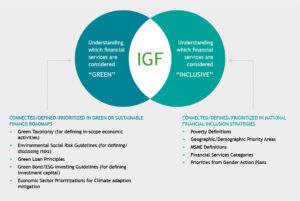by AFI’s Laura Ramos (Policy Manager, Inclusive Green Finance) and Luis Trevino (Senior Policy Manager, Financial Inclusion Data)
The lack of data is one of the main obstacles in defining and monitoring inclusive green finance (IGF) policies. Challenges in collecting IGF data include data availability, data reliability, methodological challenges, comparability of data and open issues on compatible green finance definitions and green taxonomies.
Globally, there has been a call to action to address these issues, though there is no unified approach.
This special report examines the intersection of trends between green finance measurement approaches and supply-side financial inclusion indicators. These factors have an important role for the micro, small and medium enterprises (MSMEs) sector as they play a relevant role in providing employment, goods and services, and contribute to gross domestic product.
The report also identifies the priorities in inclusive green finance regulatory reporting of AFI member institutions, that may be relevant to other policymakers and financial regulatory authorities responsible for financial inclusion and climate change
What is the relevant climate-related data that policymakers and financial regulators collect?
There is no consensus on what data ought to be collected from financial institutions, but it was identified three key themes where data play a role in assessing climate-related risks into risk management.
The lack of sex disaggregated data also needs to be addressed to understand the structural issues facing access to finance for women and women owned or women-led MSMEs. Women in developing countries possess extraordinary potential to contribute to climate change mitigation and have unique needs for climate change adaptation. The overlay of a gender lens on IGF policies and practices is thus a critical facet of a sustainable transition.
The Measuring Inclusive Green Finance Special Report is organized into the following three themes that were found to be recurring priorities for IGF data amongst AFI members:
| |

|

|

|
| |
I.
ASSESSING THE INTEGRATION OF CLIMATE RISK
MANAGEMENT IN MSME
SEGMENTS
|
II.
MEASURING FUNDING
FOR IGF
|
III.
MEASURING THE PROVISION OF INCLUSIVE GREEN FINANCIAL PRODUCTS
|
| Data themes |
Financial regulators
and policymakers
need to ensure that
financial institutions are
adequately managing
the climate risks of their
portfolio of customers |
Financial regulators and
policymakers need to
monitor the availability
of capital for funding
inclusive and green
segments |
Financial regulators and
policymakers need to
track the provision and
delivery of inclusive
green financial products
(supply side) |
| Types of data |
Supervisors, financial
institutions, third party
data providers, survey
data, environmental data,
stress test results |
Funding allocations,
disbursements/
utilizations, fund
performance indicators |
Supply-side financial and
transactional data such
as volumes and number
of financial instruments
deployed |
| Data sources |
Supervisors, Financial
Institutions, Third-party
Data providers (credit
Bureaus, environmental
ministries, rating
agencies, ESG data firms,
etc.) |
DFIs, IGOs, climate and
sustainable finance/
investment commissions,
finance ministries,
investment funds |
Financial institutions,
payment processors,
insurance providers,
credit guarantee
providers |
I. ASSESSING THE INTEGRATION OF CLIMATE RISK MANAGEMENT IN MSME SEGMENTS
Integrating climate risk data into risk management processes is inherently challenging for banks and insurers, but even more so in non-banking financial institutions (NBFI). The lack of data on many key factors which key actors of the financial sector need to understand to manage climate risks is the recurring theme. A better developed and nuanced approach to risk management that utilizes more granular climate risk data (for example, climate scenario modeling of client production metrics, reliance on energy sources, and data on the geolocation of assets), would allow banks and insurers to more accurately reflect climate risks in their business decisions.
Numerous global initiatives, such as the Sustainable Accounting Standards Board (SASB), the Global Reporting Initiative (GRI), the Task Force on Climate-related Financial Disclosures (TCFD), and the Carbon Disclosure Project (CDP), are working to develop business disclosure standards and define materiality to support aspects of climate risk disclosure.
Current climate risk disclosure frameworks typically apply to large and listed corporations and there will be challenges at the MSME level where data gaps may remain for some time. Therefore, supervisors will likely have to make substantial and concerted efforts to promote the development of additional climate-related risk data sources for MSME segments in order to gain a comprehensive view of risk exposure of the balance sheets of the financial institutions they supervise.
II. MEASURING FUNDING FOR IGF
Data insights about the sources, availability and performance of inclusive green investments and available financing are increasingly becoming relevant in the AFI network. Mapping such flows and understanding how, for example, the Sustainable Development Goals (SDGs) are being financed and tracked by a variety of investors at the national level, contributes to forming a reliable and comprehensive picture
The funding sources for IGF may come from a wide range of stakeholders, public or private, and thus, it should all be considered to form a holistic view of the state of investment and available capital.
III. MEASURING THE PROVISION OF INCLUSIVE GREEN FINANCIAL PRODUCTS
Throughout the AFI network, many regulators have been collecting data from financial service providers (FSPs) about the state of financial inclusion, in much the same manner as data has been collected about the assessment on the stability of the financial system.
On the green finance side, a few jurisdictions have adopted green definitions which are defined through a national taxonomy or industry guidelines and may present opportunities to cross-reference reporting to measure the provision of inclusive green products and services.

What are the main recommendations for improving IGF data reporting?
- Cooperate with other regulators and agencies where necessary: To obtain a unified view of IGF, regulators should work together to ensure that collected data sets are consistent and can be combined.
- Leverage ongoing international activities with respect to sustainable finance data: The central banking community is already playing a leading role in developing climate finance-related initiatives led by international organizations.
- Close data gaps by improving data collection and dissemination activities: Adhere to best practices for data protection and security control.
- Standardize reporting across jurisdictions: The development of a common data lexicon remains a critical missing link in the harmonization of indicators, the unification of data sets, and the establishment of benchmarks for sustainable finance.
Detailed, specific recommendations for each of the three themes are available in our special report: Measuring Inclusive Green Finance.
The report also identifies priorities of AFI member institutions in inclusive green finance regulatory reporting that may be relevant to other policymakers and financial regulatory authorities responsible for financial inclusion and climate change development agendas. The concepts covered in this report may also convey potential indicators for the greening of a National Financial Inclusion Strategy (NFIS).
AFI’s Inclusive Green Finance workstream is part of the International Climate Initiative (IKI), supported by the German Federal Ministry for Economic Affairs and Climate Action (BMWK), based on a decision by the German Bundestag.

 About
About
 Online
Online
 Data
Data





















